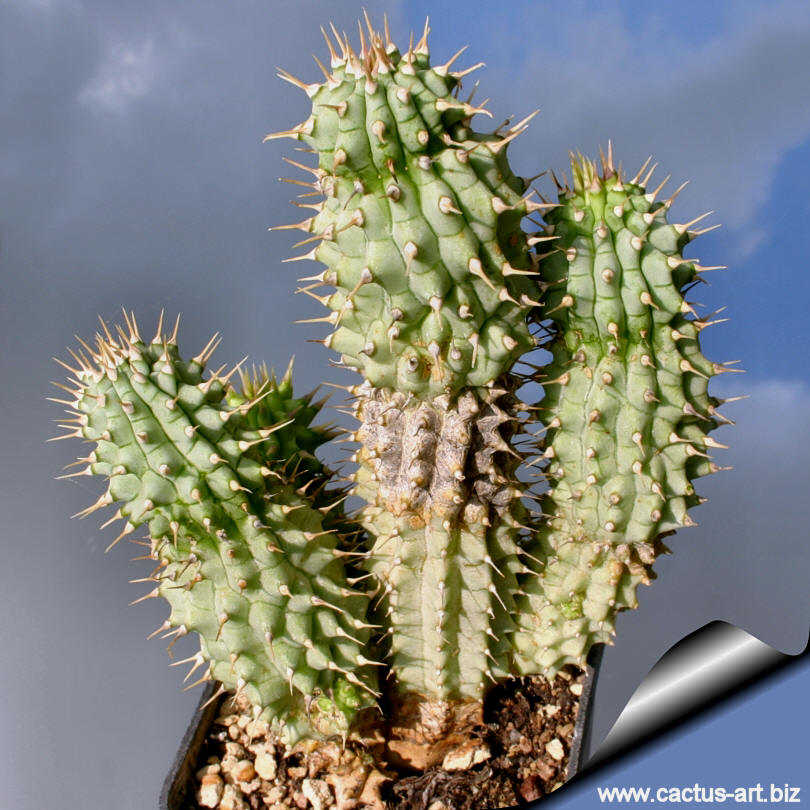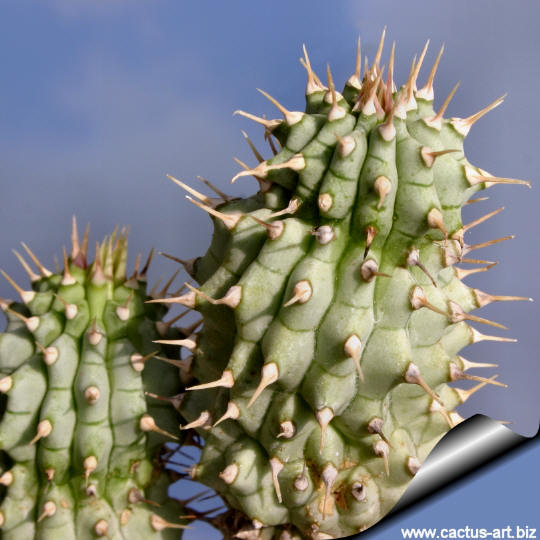|
|
|

Hoodia gordonii
It has been called one of the "wonder plants" of the twenty first
century, widely used as
an appetite suppressant in
slimming
pill
.
|
|
Description: Hoodia
gordonii is a leafless fat-stemmed and spiny succulent plant similar to
a cactus. In the early stages only one stem is produced but at a later
stage the plant produces clusters of green upright stem. Mature plants
can have as many as 50 individual branches and weigh as much as 30 kg.
Plants under ideal conditions can attain a height of 1 m. Hoodia
gordonii can under ideal conditions live for 25 years in cultivation. In
the wild they probably don't live much longer than 15 years.
Stem: 0,5-1 m tall, greysh-green to pale brown, stricltly
cylindrical, 2,5-5 in diameter. The knobbly surface helps to scatter the
sun's radiation, minimising the amount of heat they absorb.
Tubercles: Protruding, blunt, arranged in 11-17 rbs. Apically
with an acute spine.
Spine: 6-12 mm long.
Flower: Saucer-shaped, strictly 5-lobed with a central
depression, large up to 75 mm, pale straw, pale purple to dark maroon
colored and usually with darker venation (vaguely resembleing a petunia
flower) borne on or near the terminal apex (top part of the plant),
inflorescence very shortly pedunculate, with group of 1-4 flowers. The
flowers smell like rotten meat and are pollinated mainly by flies.
Blooming season: Flowers are normally borne in August or
September. Hoodia takes duration of 5 years to be completely mature,
till its flowers appear.
Fruit: The seed capsules resemble small antelope or goat horns.
Seeds: The seeds are light brown in colour, are flat and have a
pappus of fluffy hair attached to their one end. This pappus acts as a
parachute when the seed pod splits open. The seeds are blown some
distance from the parent plant where they will establish themselves.
Note: There are many difficulty in Hoodia identification. If we have
some plants from unidentified origin ( plants provided unlabeled or with
poor identification data), we have to wait until the plant is in flower
and also specialists and growers have quite a difficulty to identify
correctly this plants.
Medicinal
uses: Hoodia
gordonii has long been known by the indigenous populations of
Southern Africa that have been using it for centuries to stave off
hunger during their long and arduous hunting trips in the harsh South
African wild and also for treating indigestion and small infections.
Nowadays Hoodia is used as a component in diet pills that leads to the
purpose of weight loss and is remarkably wanted in developed countries.
It has been called one of the "wonder plants" of the twenty first
century.
The stems of Hoodia plants that have had their spines removed are the
preferred portion of the Hoodia plant for eating. Some manufacturers of
dietary supplements describe the use of stems in their slimming pill ,
but this statement is quite inaccurate, because it is the whole aerial
part of the plant that is dried for the preparation of bulk Hoodia
powder. Hoodia species have a bitter taste, which is quite noticeable
after eating.
Propagation:
Propagation is done
mainly from seed. Cuttings are not really an option, as the severed ends
very rarely form a callus from where roots will eventually form. Seeds
are produced in March and April of each year (Europe). The seed horns
must be semi-dry and starting to split down the middle before seed can
be collected.
If you try to take a cutting allows it to
dry several days
before
planting.
|
|
Advertising
|
|
|
|
|
Family:
Asclepiadaceae (Apocynaceae)
(Milkweeds family) Accepted
Scientific name: Hoodia
gordonii (Masson) sweet ex Decaisne
In: PSRV 8:665, 1884
Origin: It
grows naturally in a very wide area of the Kalahari desert in South
Africa and Namibia. It is also found in the deserts of Botswana and
Angola.
Habitat: Grows in
winter-rainfall regions in deep Kalahari sands, on dry stony slopes or
flats often under the protection of xerophytic bushes but it has a wide
tolerance of growing habitats. In places where the temperature soars
past 50°C , but it can survive in relatively low temperatures (-3°C). This
area is home to a wide range of unique plant species.
Ecology:
Pollination is done mainly by flies. This unusual pollination biology is
referred to as myophily (pollination by flies). Myophily takes place in
some of the following genera, Stapelia, Huernia and Ceropegia. Life for
a young Hoodia plant begins under the protection of a nurse plant. A
nurse plant is a shrub under which the young plant germinates and grows,
protected by its leaves and branches from the suns strong rays.
Conservation status: Listed in
CITES appendix 2.
Common English Names include: Hoodia
Etymology: It has been
named in honour of Van Hood, a keen succulent grower while the species
name comes from Col. R.F. Gordon (1743- 1795) who found it December 1778
in the Upington area.
Synonyms:
- Stapelia gordinii
Masson 1797
- Gonostemon gordonii
(Masson) Sweet 1826
- Monothylaceum
gordonii (Masson) Don 1837
- Scytanthus gordonii
(Masson) Hooker 1844
|
|
|
|

Cultivation:
It is
one of easiest species to grow but prone to root rot due to
overwaterings and lack of fresh air.
Water normally in the
growing season, sparsely in the winter. It is usually recommended to
over-winter
them in warm conditions (at 10° C),
but despite their African
origins they seem
to grow well and flower without the extra heat which one might have
thought necessary, and
occasional temperatures
near 0°C (or less).
are tolerated, if kept
dry.
Spring:
In
the spring leaving them out in the rain may provide them with the
water they need.
Summer:
In
the summer months they will grow well in
full sun or
partial shade and tolerate heavy
rain, but will be just as happy if the season is
dry.
Potting medium:
Since roots are quite shallow, a gritty,
very free-draining
compost with extra
perlite or
pumiceis suitable, and
clay pots help the plants to dry out between watering.
Indoors only in
brightest position,

 |
|